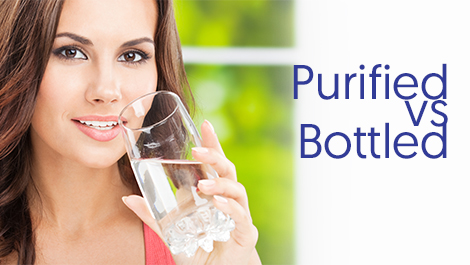Water Filtration Systems vs. Plastic Water Bottles
Posted by Intelgadgets.com on 15th Dec 2015

Plastic water bottles have infiltrated today’s society, appearing almost everywhere we turn. In fact, the chances are very high that you, whether you’re at home, work, or elsewhere, will find at least 1 water bottle in your view if you look around you right now. If not, there are most likely a few very close by.
Over the past 10 years, the purchase and utilization of plastic water bottles have grown exponentially for a number of reasons. More and more people are realizing just how important water consumption is for life and health. Subsequently, not only are more people beginning to drink water, but they are also realizing just how much one should consume per day. The numbers are very high. Although the precise amount may vary from person to person depending on health, size, age, location, diet, and many other factors, the average consensus is approximately eight 8oz glasses, which totals about 2 liters, each day. For avid water drinkers, this doesn’t sound like a lot at all, but to those who are just beginning their healthy water regiment, drinking 2 liters of water a day may sound daunting. Well, it doesn’t have to be, especially if you own a water filtration system.
One of the main reasons for the increase in bottled water sales and consumption is safety. Municipal and well water contamination cases have become regular occurrences on the daily news in some areas and most citizens have just become accustomed to not using their tap water. And while droves of people are reaching for water bottles, many are also learning the truth about bottled water as well, like where it’s actually obtained and the contaminants and impurities it contains.
Most bottled spring water is not actually bottled at the mountain springs or other pure sources they may claim to be. Oftentimes, the plastic bottles you purchase were filled at municipal sources or other locations and they often contain contaminants. Another major hazard with plastic water bottles is the leaching of chemicals from the plastic into the water. The more time the water sits in the plastic bottles, the higher the concentration of dangerous chemicals in the supposed “pure” water.
If you don’t believe this information, just measure the TDS (Total Dissolved Solids) of the water from a few of the top-leading bottled water brands. (Many quality TDS meters and other water quality testers are available in today’s market). The results are not reassuring.
So, if you can’t rely on bottled spring water to be pure and safe, where can you find clean water to drink?
One excellent solution is purchasing a water filtration system. In addition to saving tons of money on plastic water bottles and freeing up a ton of space in the fridge, plus all the hassle of lugging around large cases of bottled water and then disposing of and recycling them, owning the right water purifier can be the perfect plan.
After reviewing the hazards of plastic water bottles, you may be inclined to purchase a water purification system for your home, but the key is to find the right one for you.
Here Are 4 Water Filtration Options:
- Water Pitchers and Tap-Mounted Filters: These devices usually use granulated charcoal or activated carbon to filter water and reduce chlorine. Downside: These types of water filters are not effective at reducing VOC’s (Volatile Organic Chemicals), fluoride, rust, heavy metals, or endocrine-disrupting chemicals found in tap water. They can also cause the water to have a foul odor and taste.
- Distillation: Effective at killing bacteria, distillation purifies water by heating it, capturing the steam in a cooling chamber, and then condensing it back into water. This method also reduces large-particle contaminants such as heavy metals and minerals by causing them to dislodge from the water molecules. Downside: Although available in a range of sizes from countertop to whole house filtration, these systems require electricity to operate, and some of them in very high, inefficient amounts. Not only will you be wasting a great deal of electricity, but you will also be unable to use the distillation machine during a power outage. In addition, this method is ineffective at filtering VOC’s and endocrine disruptors.
- Solid Block Carbon Filters: Using gravity to pull water through a solid carbon filter, these require no electricity and are available in portable models. Downside: these systems can be expensive and cumbersome, and many take up a great deal of counter space.
- Reverse Osmosis: This filtration method requires no electricity and purifies water by drawing it through a fine membrane with applied pressure. The contaminants remain so that only pure water flows through for drinking. Some reverse osmosis systems remove up to 99% of impurities including but not limited to fluoride, chlorine, bacteria, algae, dirt, suspended sediment, limescale, rust, heavy metals, pesticides, chemicals, viruses, cysts, germs, and parasites. Many RO machines are small and some, like the Aquaphor Water Filters RO 101, are so compact that they fit neatly under the kitchen sink. Downside: Some people might complain about the wastewater produced during reverse osmosis; however, this is actually what makes this method so effective and it’s usually not a concern for most RO users. Some have even designed creative ways to use the wastewater for other purposes such as lawn and flowerbed watering.
With the proper water filtration system, you may never have to worry about contamination, unpleasant taste, foul odor, or other water quality concerns again.
